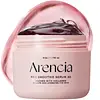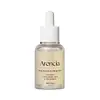What's inside
What's inside
 Key Ingredients
Key Ingredients

 Benefits
Benefits

 Concerns
Concerns

No concerns
 Ingredients Side-by-side
Ingredients Side-by-side

Water
Skin ConditioningGlycerin
HumectantNiacinamide
SmoothingArbutin
AntioxidantPropanediol
Solvent1,2-Hexanediol
Skin ConditioningButylene Glycol
HumectantMethylpropanediol
SolventAmmonium Acryloyldimethyltaurate/Vp Copolymer
Acrylates/C10-30 Alkyl Acrylate Crosspolymer
Emulsion StabilisingArginine
MaskingGardenia Florida Fruit Extract
Skin ConditioningEthylhexylglycerin
Skin ConditioningDextrin
AbsorbentAdenosine
Skin ConditioningPolyglyceryl-10 Myristate
Skin ConditioningPolyglyceryl-10 Laurate
Skin ConditioningPanax Ginseng Berry Extract
Skin ConditioningGlyceryl Acrylate/Acrylic Acid Copolymer
HumectantPersea Gratissima Fruit Extract
EmollientRibes Nigrum Fruit Extract
AstringentInonotus Obliquus Extract
Skin ConditioningBrassica Oleracea Acephala Leaf Extract
HumectantPvm/Ma Copolymer
Emulsion StabilisingSaccharomyces/Rice Ferment Filtrate
Skin ConditioningSodium Hyaluronate
HumectantFerulic Acid
AntimicrobialBeta Vulgaris Root Extract
Skin ConditioningVaccinium Vitis-Idaea Fruit Extract
AntioxidantRosa Gallica Flower Extract
AstringentHibiscus Sabdariffa Flower Extract
Skin ConditioningRosa Canina Fruit Extract
AstringentHexapeptide-2
BleachingSoluble Collagen
HumectantHydrolyzed Dna
Skin ConditioningBiotin
Antiseborrhoeic3-O-Ethyl Ascorbic Acid
Skin ConditioningSodium Ascorbyl Phosphate
AntioxidantAscorbic Acid
AntioxidantAscorbyl Glucoside
AntioxidantTocopherol
AntioxidantPanthenol
Skin ConditioningPyridoxine
Skin ConditioningWater, Glycerin, Niacinamide, Arbutin, Propanediol, 1,2-Hexanediol, Butylene Glycol, Methylpropanediol, Ammonium Acryloyldimethyltaurate/Vp Copolymer, Acrylates/C10-30 Alkyl Acrylate Crosspolymer, Arginine, Gardenia Florida Fruit Extract, Ethylhexylglycerin, Dextrin, Adenosine, Polyglyceryl-10 Myristate, Polyglyceryl-10 Laurate, Panax Ginseng Berry Extract, Glyceryl Acrylate/Acrylic Acid Copolymer, Persea Gratissima Fruit Extract, Ribes Nigrum Fruit Extract, Inonotus Obliquus Extract, Brassica Oleracea Acephala Leaf Extract, Pvm/Ma Copolymer, Saccharomyces/Rice Ferment Filtrate, Sodium Hyaluronate, Ferulic Acid, Beta Vulgaris Root Extract, Vaccinium Vitis-Idaea Fruit Extract, Rosa Gallica Flower Extract, Hibiscus Sabdariffa Flower Extract, Rosa Canina Fruit Extract, Hexapeptide-2, Soluble Collagen, Hydrolyzed Dna, Biotin, 3-O-Ethyl Ascorbic Acid, Sodium Ascorbyl Phosphate, Ascorbic Acid, Ascorbyl Glucoside, Tocopherol, Panthenol, Pyridoxine
Rice Ferment Filtrate
Skin ConditioningWater
Skin ConditioningButylene Glycol
Humectant1,2-Hexanediol
Skin ConditioningNiacinamide
SmoothingYeast
Skin ConditioningGlycerin
HumectantHydrolyzed Collagen
EmollientMethylpropanediol
SolventPentylene Glycol
Skin ConditioningCaprylic/Capric Triglyceride
MaskingPEG-60 Hydrogenated Castor Oil
EmulsifyingCarbomer
Emulsion StabilisingSodium Hyaluronate
HumectantHydrolyzed Hyaluronic Acid
HumectantHyaluronic Acid
HumectantHydrogenated Lecithin
EmulsifyingInulin Lauryl Carbamate
Emulsion StabilisingBetaine
HumectantTromethamine
BufferingSodium Polyacrylate
AbsorbentGarcinia Cambogia Fruit Extract
Skin ConditioningAdenosine
Skin ConditioningPolyglutamic Acid
Skin ConditioningPolyglyceryl-10 Oleate
Skin ConditioningOryza Sativa Extract
AbsorbentPolyglyceryl-10 Stearate
Skin ConditioningDisodium EDTA
Capryloyl Salicylic Acid
ExfoliatingPolyglyceryl-4 Caprate
EmulsifyingMalt Extract
Skin ProtectingRetinol
Skin ConditioningPanthenol
Skin ConditioningEel Extract
HumectantSodium Ascorbyl Phosphate
AntioxidantTocopheryl Acetate
AntioxidantCinchona Calisaya Bark Extract
Skin ConditioningZea Mays Leaf Extract
Skin ConditioningTranexamic Acid
AstringentDioscorea Villosa Root Extract
Skin ConditioningBeta-Glucan
Skin ConditioningHydrolyzed Corn Starch
HumectantGlyceryl Linolenate
EmollientGlyceryl Arachidonate
EmollientRetinyl Palmitate
Skin ConditioningBiotin
AntiseborrhoeicSucrose
HumectantThiamine Hcl
MaskingFolic Acid
Skin ConditioningPyridoxine
Skin ConditioningCyanocobalamin
Skin ConditioningSodium Chondroitin Sulfate
Skin ConditioningRice Ferment Filtrate, Water, Butylene Glycol, 1,2-Hexanediol, Niacinamide, Yeast, Glycerin, Hydrolyzed Collagen, Methylpropanediol, Pentylene Glycol, Caprylic/Capric Triglyceride, PEG-60 Hydrogenated Castor Oil, Carbomer, Sodium Hyaluronate, Hydrolyzed Hyaluronic Acid, Hyaluronic Acid, Hydrogenated Lecithin, Inulin Lauryl Carbamate, Betaine, Tromethamine, Sodium Polyacrylate, Garcinia Cambogia Fruit Extract, Adenosine, Polyglutamic Acid, Polyglyceryl-10 Oleate, Oryza Sativa Extract, Polyglyceryl-10 Stearate, Disodium EDTA, Capryloyl Salicylic Acid, Polyglyceryl-4 Caprate, Malt Extract, Retinol, Panthenol, Eel Extract, Sodium Ascorbyl Phosphate, Tocopheryl Acetate, Cinchona Calisaya Bark Extract, Zea Mays Leaf Extract, Tranexamic Acid, Dioscorea Villosa Root Extract, Beta-Glucan, Hydrolyzed Corn Starch, Glyceryl Linolenate, Glyceryl Arachidonate, Retinyl Palmitate, Biotin, Sucrose, Thiamine Hcl, Folic Acid, Pyridoxine, Cyanocobalamin, Sodium Chondroitin Sulfate
Ingredients Explained
These ingredients are found in both products.
Ingredients higher up in an ingredient list are typically present in a larger amount.
1,2-Hexanediol is a synthetic liquid and another multi-functional powerhouse.
It is a:
- Humectant, drawing moisture into the skin
- Emollient, helping to soften skin
- Solvent, dispersing and stabilizing formulas
- Preservative booster, enhancing the antimicrobial activity of other preservatives
Adenosine is in every living organism. It is one of four components in nucleic acids that helps store our DNA.
Adenosine has many benefits when used. These benefits include hydrating the skin, smoothing skin, and reducing wrinkles. Once applied, adenosine increases collagen production. It also helps with improving firmness and tissue repair.
Studies have found adenosine may also help with wound healing.
In skincare products, Adenosine is usually derived from yeast.
Learn more about AdenosineBiotin is a B vitamin that is naturally produced by our bodies. It is also called Vitamin H.
Our bodies use biotin in the metabolism process. It also helps our bodies use enzymes and move nutrients around. A biotin deficiency can lead to brittle hair and nails.
More research is needed on applying biotin topically. However, taking biotin orally has been shown to help nourish the skin, hair, and nails. They play a role in forming skin-hydrating fatty acids.
Biotin is water-soluble. It can be found in foods such as fish, eggs, dairy, nuts, and meat. Vitamin H stands for "haar" and "haut". These are the German words for hair and skin.
Learn more about BiotinButylene Glycol (or BG) is used within cosmetic products for a few different reasons:
Overall, Butylene Glycol is a safe and well-rounded ingredient that works well with other ingredients.
Though this ingredient works well with most skin types, some people with sensitive skin may experience a reaction such as allergic rashes, closed comedones, or itchiness.
Learn more about Butylene GlycolGlycerin is already naturally found in your skin. It helps moisturize and protect your skin.
A study from 2016 found glycerin to be more effective as a humectant than AHAs and hyaluronic acid.
As a humectant, it helps the skin stay hydrated by pulling moisture to your skin. The low molecular weight of glycerin allows it to pull moisture into the deeper layers of your skin.
Hydrated skin improves your skin barrier; Your skin barrier helps protect against irritants and bacteria.
Glycerin has also been found to have antimicrobial and antiviral properties. Due to these properties, glycerin is often used in wound and burn treatments.
In cosmetics, glycerin is usually derived from plants such as soybean or palm. However, it can also be sourced from animals, such as tallow or animal fat.
This ingredient is organic, colorless, odorless, and non-toxic.
Glycerin is the name for this ingredient in American English. British English uses Glycerol/Glycerine.
Learn more about GlycerinMethylpropanediol is a synthetic solvent and humectant.
As a solvent, it helps dissolve other ingredients, helping to evenly distribute ingredients throughout the product. This ingredient has also been shown to have antimicrobial properties which makes it a preservative booster.
Methylpropanediol is able to add a bit of moisture to the skin. It also helps other ingredients be better absorbed into the skin, such as salicylic acid.
Learn more about MethylpropanediolNiacinamide is a multitasking form of vitamin B3 that strengthens the skin barrier, reduces pores and dark spots, regulates oil, and improves signs of aging.
And the best part? It's gentle and well-tolerated by most skin types, including sensitive and reactive skin.
You might have heard of "niacin flush", or the reddening of skin that causes itchiness. Niacinamide has not been found to cause this.
In very rare cases, some individuals may not be able to tolerate niacinamide at all or experience an allergic reaction to it.
If you are experiencing flaking, irritation, and dryness with this ingredient, be sure to double check all your products as this ingredient can be found in all categories of skincare.
When incorporating niacinamide into your routine, look out for concentration amounts. Typically, 5% niacinamide provides benefits such as fading dark spots. However, if you have sensitive skin, it is better to begin with a smaller concentration.
When you apply niacinamide to your skin, your body converts it into nicotinamide adenine dinucleotide (NAD). NAD is an essential coenzyme that is already found in your cells as "fuel" and powers countless biological processes.
In your skin, NAD helps repair cell damage, produce new healthy cells, support collagen production, strengthen the skin barrier, and fight environmental stressors (like UV and pollution).
Our natural NAD levels start to decline with age, leading to slower skin repair, visible aging, and a weaker skin barrier. By providing your skin niacinamide, you're recharging your skin's NAD levels. This leads to stronger, healthier, and younger looking skin.
Another name for vitamin B3 is nicotinamide. This vitamin is water-soluble and our bodies don't store it. We obtain Vitamin B3 from either food or skincare. Meat, fish, wheat, yeast, and leafy greens contain vitamin B3.
The type of niacinamide used in skincare is synthetically created.
Learn more about NiacinamidePanthenol is a common ingredient that helps hydrate and soothe the skin. It is found naturally in our skin and hair.
There are two forms of panthenol: D and L.
D-panthenol is also known as dexpanthenol. Most cosmetics use dexpanthenol or a mixture of D and L-panthenol.
Panthenol is famous due to its ability to go deeper into the skin's layers. Using this ingredient has numerous pros (and no cons):
Like hyaluronic acid, panthenol is a humectant. Humectants are able to bind and hold large amounts of water to keep skin hydrated.
This ingredient works well for wound healing. It works by increasing tissue in the wound and helps close open wounds.
Once oxidized, panthenol converts to pantothenic acid. Panthothenic acid is found in all living cells.
This ingredient is also referred to as pro-vitamin B5.
Learn more about PanthenolWe don't have a description for Pyridoxine yet.
Sodium Ascorbyl Phosphate is a form of Vitamin C. It is the salt of ascorbic acid.
This ingredient is more gentle than ascorbic acid. It is also more stable when exposed to light and oxygen.
Vitamin C helps reduce redness, improve skin texture, reduce the effects of aging, reduce the visibility of dark spots, and brighten skin.
Your skin uses Vitamin C to produce collagen and collagen production plays a role in having a strong skin barrier and plump skin. As an antioxidant, this ingredient also helps reduce the signs of aging such as fine-lines and wrinkles.
VItamin C helps brighten skin by blocking the process of skin darkening.
In a 2011 study, Sodium Ascorbyl Phosphate was found to have antibacterial properties. This may help treat acne.
Read more about other types of Vitamin C:
Learn more about Sodium Ascorbyl PhosphateSodium Hyaluronate is hyaluronic acid's salt form. It is commonly derived from the sodium salt of hyaluronic acid.
Like hyaluronic acid, it is great at holding water and acts as a humectant. This makes it a great skin hydrating ingredient.
Sodium Hyaluronate is naturally occurring in our bodies and is mostly found in eye fluid and joints.
These are some other common types of Hyaluronic Acid:
Learn more about Sodium HyaluronateWater. It's the most common cosmetic ingredient of all. You'll usually see it at the top of ingredient lists, meaning that it makes up the largest part of the product.
So why is it so popular? Water most often acts as a solvent - this means that it helps dissolve other ingredients into the formulation.
You'll also recognize water as that liquid we all need to stay alive. If you see this, drink a glass of water. Stay hydrated!
Learn more about Water